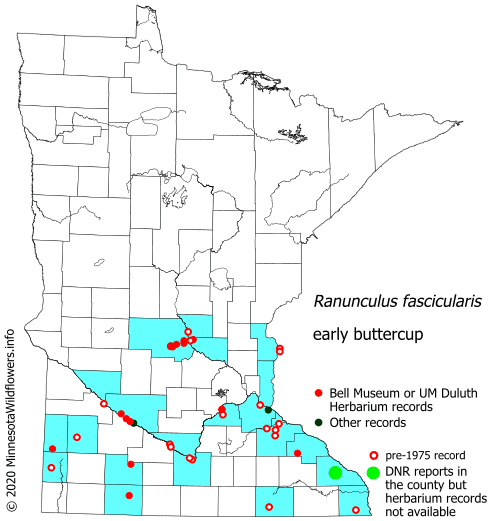Ranunculus fascicularis
Early buttercup Description:
Ranunculus fascicularis, commonly known as Early Buttercup, is a perennial herbaceous plant native to North America. It can be found growing in a variety of habitats, including meadows, grasslands, and forests, and is often seen blooming in early spring. The plant produces bright yellow flowers with glossy petals that are arranged in loose clusters at the top of slender stems. The basal leaves of Ranunculus fascicularis are lobed and deeply cut, while the stem leaves are linear and more simple. The flowers are surrounded by small bracts that are palmate and divided into several narrow lobes. After pollination, the plant produces achenes that are dispersed by the wind.
In the wild, Ranunculus fascicularis provides food for a variety of pollinators, including bees, flies, butterflies, and hummingbirds. The bright yellow flowers are especially attractive to bees, which collect nectar and pollen from the plant. In addition to its ecological value, Ranunculus fascicularis is also of interest to gardeners, who appreciate its early spring blooms and cheerful yellow flowers. While the plant can be somewhat invasive in garden settings, it can also be used as a groundcover or as part of a wildflower garden. Overall, Ranunculus fascicularis is a charming and important plant that deserves recognition and appreciation.
Native Range:
Early buttercup is found in the central and Eastern United States. In Minnesota, Early buttercup is found mostly in the southern portions of the state.
Standard Plant Information:
Plant Height: 4" - 12" inches
Bloom Time: April - May
Preferred Habitat: Does well in part shade to full sun. Often found in dry prairies and open woods.
Sowing:
For most homeowners, the best option is to scatter seed on the ground by hand broadcasting at a minimum of 16-64 pls ounces per acre. For even coverage, we recommend that you broadcast seed in perpendicular rows across the site to ensure even coverage.
You’ll want to broadcast any grass seed first, which will get raked into the soil lightly. Next, it is ideal to mulch the area lightly with either a clean (no seed) straw or preferably with our native Little Bluestem straw, sold at our retail garden centers. After a light mulching is complete, now it’s time to broadcast your native wildflower seeds, which should not be raked into the soil. A good rain or watering is sufficient to cover the seed.
Planting:
Simply dig a hole in the soil slightly larger than the plant’s roots. Ensure that the soil line of the plant is maintained during the transfer (i.e. the plant should be at the same level with the ground as it was in the pot). Pack any loose dirt back around the plant and make sure you water it well the same day to ensure it has the best chance of survival.








